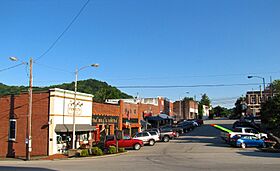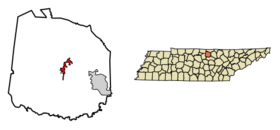Gainesboro, Tennessee facts for kids
Quick facts for kids
Gainesboro, Tennessee
|
|
|---|---|

Downtown Gainesboro
|
|

Location of Gainesboro in Jackson County and Tennessee.
|
|
| Country | United States |
| State | Tennessee |
| County | Jackson |
| Settled | 1790s |
| Established | 1817 |
| Incorporated | 1905 |
| Named for | Edmund P. Gaines |
| Area | |
| • Total | 1.78 sq mi (4.61 km2) |
| • Land | 1.56 sq mi (4.03 km2) |
| • Water | 0.22 sq mi (0.58 km2) |
| Elevation | 574 ft (175 m) |
| Population
(2020)
|
|
| • Total | 920 |
| • Density | 590.88/sq mi (228.20/km2) |
| Time zone | UTC-6 (Central (CST)) |
| • Summer (DST) | UTC-5 (CDT) |
| ZIP code |
38562
|
| Area code(s) | 931 |
| FIPS code | 47-28420 |
| GNIS feature ID | 1285070 |
Gainesboro is a small town in Jackson County, Tennessee, United States. It is the main town, also known as the county seat, of Jackson County. In 2020, about 920 people lived there.
Gainesboro is also part of the larger Cookeville, Tennessee area. This means it's connected to the economic and social life of Cookeville.
Contents
History of Gainesboro
The area around Gainesboro was popular with "long hunters" as early as the 1770s. Long hunters were explorers and hunters who stayed in the wilderness for a long time. They were drawn to the area because of natural "salt licks," which are places where animals gather to lick salt from the ground. This meant lots of game for hunting.
In the 1790s, an important road called Avery's Trace passed nearby. Travelers on this road often stayed at Fort Blount, which was about 10 miles away. The town of Gainesboro was named after Edmund P. Gaines. He was a famous United States Army general.
Gainesboro has been the county seat of Jackson County since 1820. This means it's where the county government offices are located. A movie called I Walk the Line was filmed in Gainesboro in 1970. It starred Gregory Peck and featured a song by Johnny Cash.
Geography of Gainesboro
Gainesboro is located about 15 miles northwest of Cookeville, Tennessee. The town covers a total area of about 1.8 square miles (4.6 square kilometers). Most of this area is land, about 1.6 square miles (4.0 square kilometers). The rest, about 0.3 square miles (0.58 square kilometers), is water.
Demographics of Gainesboro
| Historical population | |||
|---|---|---|---|
| Census | Pop. | %± | |
| 1880 | 352 | — | |
| 1890 | 462 | 31.3% | |
| 1910 | 408 | — | |
| 1920 | 351 | −14.0% | |
| 1930 | 556 | 58.4% | |
| 1940 | 671 | 20.7% | |
| 1950 | 992 | 47.8% | |
| 1960 | 1,021 | 2.9% | |
| 1970 | 1,101 | 7.8% | |
| 1980 | 1,119 | 1.6% | |
| 1990 | 1,002 | −10.5% | |
| 2000 | 879 | −12.3% | |
| 2010 | 962 | 9.4% | |
| 2020 | 920 | −4.4% | |
| Sources: | |||
In 2020, the 2020 United States census showed that 920 people lived in Gainesboro. There were 347 households and 152 families in the town.
Notable people from Gainesboro
- Andrew J. Allen – A talented musician who plays the classical saxophone.
- Charlotte Burks – A politician who served as a State Senator for Tennessee.
- Mounce Gore Butler – A person who was a member of the United States House of Representatives.
- Alvan Cullem Gillem – A general who served in the Union army during the American Civil War.
- John J. Gore – A judge for the United States District Court.
- Jamie Dailey – A bluegrass musician, known for being part of the group Dailey & Vincent. He is also a member of the famous Grand Ole Opry.
See also
 In Spanish: Gainesboro (Tennessee) para niños
In Spanish: Gainesboro (Tennessee) para niños

